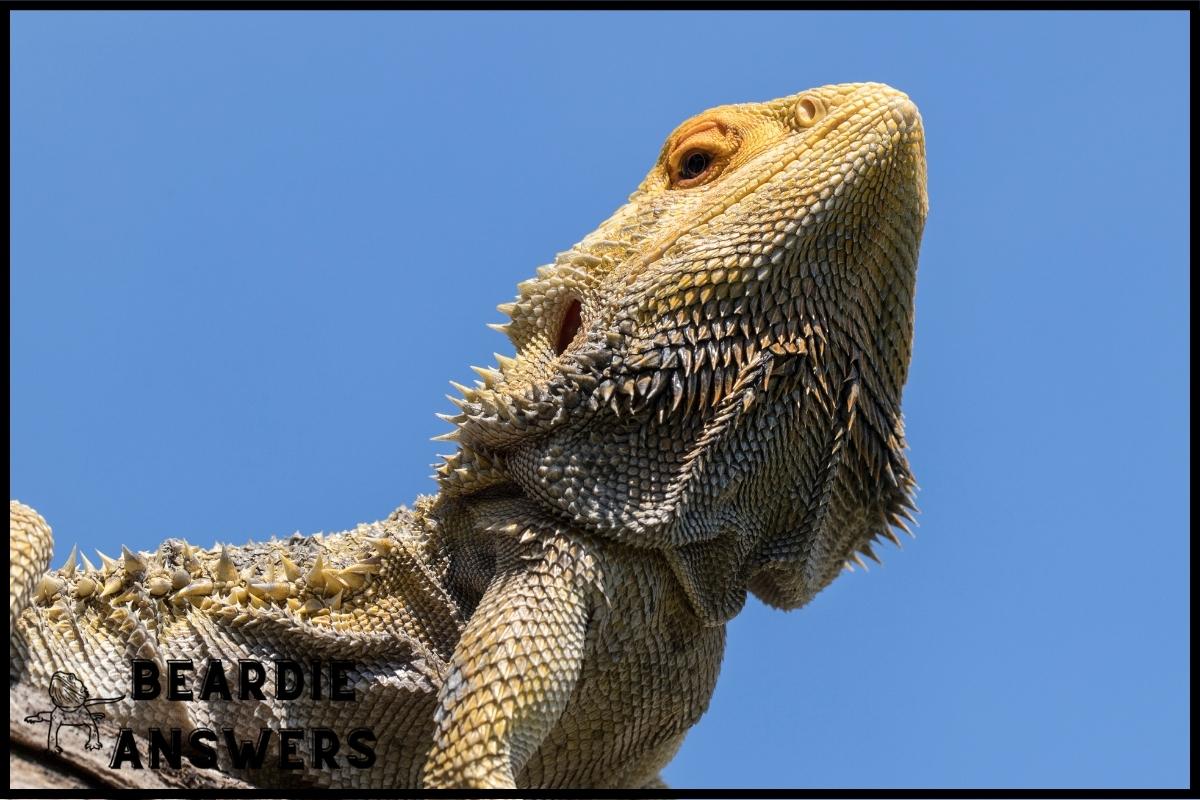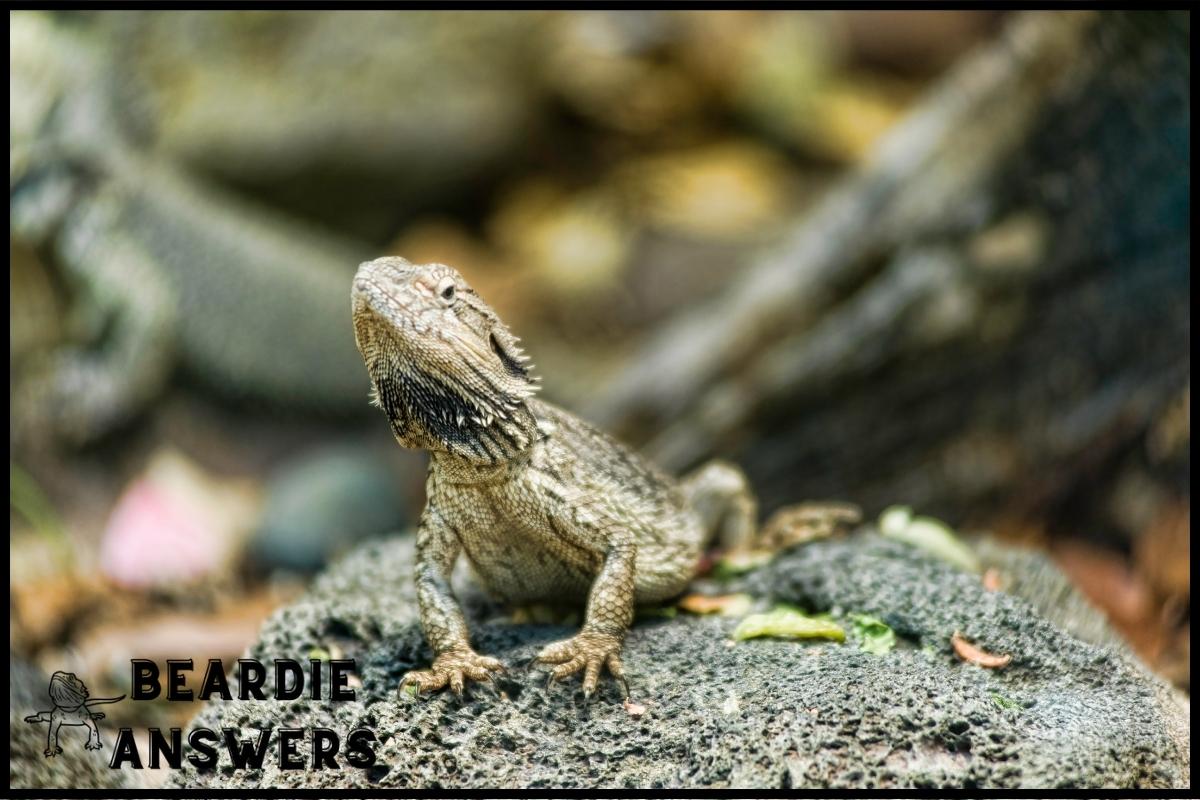[su_note note_color=”#eee”]
Bearded dragons are a popular pet choice, and they require special care to ensure their health. Setting up the light in the enclosure is an important part of that process.
In this article, we’ll discuss how to create the correct lighting set-up for your bearded dragon’s habitat using UVB and basking bulbs. This combination will provide an ideal temperature gradient for your reptile friend to thrive!
Let’s take a look at what you need to know about setting up the perfect environment for your scaly companion.
What You'll Learn
Benefits Of Proper Lighting
Proper lighting is essential for a bearded dragon’s health and wellbeing.
UVB bulbs are important to provide the necessary intensity of ultraviolet light, while basking lamps ensure that your pet has enough time in direct heat.
Heat lamps can be used as substitute for natural daylight when needed, such as during cold months or on cloudy days.
Night lights may also be beneficial to provide some illumination throughout the night without disturbing their sleep cycle.
It is important to create an ideal environment with appropriate temperatures and light levels through various types of lighting solutions.
These can range from basic incandescent or fluorescent bulbs to specially designed reptile-specific fixtures.
Types Of Lighting
Having the right lighting setup is essential for providing a healthy environment for bearded dragons. Appropriate day/night cycles, humidity levels and other environmental factors help ensure that your pet dragon will live a long and happy life.
With this in mind, it’s important to understand the various types of lighting available when setting up an enclosure. Heat mats and temperature controllers can be used to regulate temperatures within the enclosure, while extra light sources like basking lamps or UVB bulbs may also be necessary. These help create a naturalistic environment with appropriate heat gradients during both day and night time hours.
In addition, these light sources are especially important as they provide ultraviolet radiation which helps promote healthy growth in your reptile companion. Without them, vitamin D3 production would not be possible leading to calcium deficiencies and other issues related to overall health.
Choosing the right kind of lighting can make all the difference in creating an ideal habitat for bearded dragons – one that meets their needs as well as yours! When selecting lights for your beardie’s home it’s important to consider factors such as wattage, distance from the bulb and duration of use throughout each day/night cycle so you can achieve optimal results.
Setting up the proper lighting is key to giving your new dragon friend a safe and secure place to call home!
Setting Up The Lighting
Creating a perfect lighting setup for your bearded dragon can be likened to a puzzle. You need to find the correct pieces and fit them together in order to provide optimal living conditions for your pet.
The UVB sources, basking spots, light schedules, bulbs safety, and heat sources will all play an important role in creating this environment.
It’s essential that you place a quality UVB light at the top of their enclosure so they get sufficient exposure on their skin and eyes. This bulb needs to run throughout the day (8-12 hours) as part of their natural circadian rhythm.
Additionally, make sure there is enough space between it and any other lights or heating elements to prevent overheating or burns. A good basking spot should also be provided with temperatures ranging from 85°F–95°F; you may use regular incandescent bulbs or ceramic heat emitters depending on what works best for your particular enclosure size/setup.
Finally, make sure only certified reptile lights are used – don’t take any unnecessary risks when it comes to your pet’s health! Positioning these elements correctly is key; not only does this ensure proper coverage but it also prevents accidents such as thermal burns from occurring due to incorrect placement of lights or heat sources.
Positioning The Bulbs
I’m wondering what the best distance is to keep the bulbs from the dragon? What temperature gradient should I aim for? What wattage/strength of bulbs should I use?
Distance From The Dragon
When setting up your bearded dragon’s light setup, it’s important to keep the bulbs at a distance that won’t scorch them. The ideal positioning of the bulbs should be far enough away so they don’t get too hot and cause drastic temperature variations in their enclosure.
Generally speaking, UVB bulbs need to be placed 8-12 inches away from the reptile while basking bulbs can be up to 18 inches away for optimal lighting duration and intensity.
Keeping these measurements in mind is key when creating an environment that will make your dragon feel comfortable and safe!
Temperature Gradient
Now that we understand the distance for the bulbs, it’s important to create a temperature gradient within their enclosure. This will ensure your dragon is able to properly regulate body heat and get enough light exposure from the UVB spectrum.
By having both cooler spots and warmer basking areas in the tank, they can adjust as needed depending on how hot or cold they feel. Setting up rocks, branches, logs, etc., will help them move more freely throughout the various temperatures so they can find comfort wherever they are.
Without this controlled environment, your bearded dragon won’t be able to thrive.
Wattage/Strength
Once you’ve decided the right distance for your bulbs, it’s time to consider wattage and strength.
Selecting the proper wattage will depend on how large of a tank you have, as well as what temperature range you want to provide.
Lighting duration is also important, since UVB exposure should be limited; too much can damage their skin over time.
With these things in mind, pick an appropriate bulb that will provide enough light without being overwhelming or causing harm.
That way, you’ll know your bearded dragon is getting just the right amount of light for its health and wellbeing.
Reasons For Temperature Gradient
The position of the bulbs is critical for your bearded dragon’s health, but it isn’t all that matters.
Knowing why a temperature gradient is necessary and what each bulb does can help you set up an enclosure that will keep your pet healthy.
UVB wavelength helps regulate vitamin D3 production in reptiles, while basking intensity provides warmth from simulated sunlight without too much heat stress.
Temperature regulation is essential as it affects metabolic processes such as digestion and respiration, while habitat humidity should be monitored regularly to ensure proper hydration levels.
Natural sunlight also contains UVA light which has been shown to have psychological benefits on animals like the bearded dragon.
Having the right combination of UVB wavelengths, basking intensity, temperature regulation, and habitat humidity are important elements when creating an environment suitable for your pet reptile.
Allowing them access to natural sunlight through their terrariums or outdoor enclosures can provide additional enrichment opportunities during times when they aren’t under direct lighting sources.
Making sure these variables stay within acceptable ranges goes a long way towards preventing common mistakes related to bearded dragon husbandry.
Avoiding Common Mistakes
Creating the perfect living environment for a bearded dragon can be tricky, and it’s easy to make mistakes if you don’t know what to look out for. One wrong move could mean disaster, as beardies need specific conditions in order to thrive.
A few of the most common errors include improper heat sources, humidity levels that are too low or high, insufficient basking spots, incorrect lighting timers, and poor diet quality.
Heat is very important when setting up a home for your bearded dragon. Not only should they have access to both UVB and basking bulbs (as mentioned above), but these bulbs must also be placed far enough away so that temperatures stay within an acceptable range throughout the entire enclosure. Additionally, you’ll want to provide multiple hot spots with varying degrees of temperature for them to choose from – this allows them to thermoregulate properly by moving between different areas until they find their ideal comfort level.
It’s also essential that you keep an eye on humidity levels inside the habitat; any moisture content outside of 30-40% can cause health problems ranging from respiratory issues to skin irritation. Furthermore, adding some kind of hygrometer will help you accurately measure and monitor moisture levels over time.
If necessary, misting systems or even live plants can be used to increase relative humidity without creating stagnant pockets of water around the terrarium. As always though, never forget that good ventilation is key!
In addition to all of this, it’s important not to overlook other essential components such as lights (on/off cycles) and nutrition (variety). Bearded dragons rely on natural light cycles just like humans do – meaning 8-12 hours per day depending on season – so having a timer set up is critical for maintaining optimal energy levels in your pet.
And lastly: while insects may constitute most of their staple diet in captivity, supplementing with fresh veggies ensures they’re getting sufficient vitamins & minerals needed for growth and development into adulthood.
Conclusion
To ensure your bearded dragon gets the lighting it needs, it is important to set up and position the bulbs correctly. With a proper light setup, you can create an ideal temperature gradient and environment for your pet reptile. By taking these steps and avoiding common mistakes, you can provide the best possible care for your beloved beardie.
By setting up their enclosure with just the right amount of UVB and basking bulb light, you are creating a lush habitat that will make them feel like they’re in their own little paradise. You can imagine how happy they must be when they get to bask in all that warmth!
Taking good care of any pet takes time and commitment – but seeing the difference it makes in their life is worth every second spent tending to them! As a responsible pet parent, it’s our job to give them everything we can so they have long, healthy lives – including giving them access to natural sunlight or providing artificial UVB sources if necessary.

Hi! My name is Bryan, I am the “one behind the words” here are BeardieAnswers.com. I believe that providing quality care and nutrition is the best way to ensure the health of your pet. Every beardie is special and deserves the best care and attention. If you have questions about your bearded dragon, please don’t hesitate to ask! View My Full Author Page




